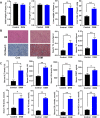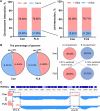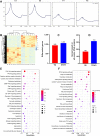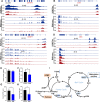Reorganization of 3D genome architecture provides insights into pathogenesis of early fatty liver disease in laying hens
- PMID: 38448979
- PMCID: PMC10919017
- DOI: 10.1186/s40104-024-01001-y
Reorganization of 3D genome architecture provides insights into pathogenesis of early fatty liver disease in laying hens
Abstract
Background: Fatty liver disease causes huge economic losses in the poultry industry due to its high occurrence and lethality rate. Three-dimensional (3D) chromatin architecture takes part in disease processing by regulating transcriptional reprogramming. The study is carried out to investigate the alterations of hepatic 3D genome and H3K27ac profiling in early fatty liver (FLS) and reveal their effect on hepatic transcriptional reprogramming in laying hens.
Results: Results show that FLS model is constructed with obvious phenotypes including hepatic visible lipid deposition as well as higher total triglyceride and cholesterol in serum. A/B compartment switching, topologically associating domain (TAD) and chromatin loop changes are identified by high-throughput/resolution chromosome conformation capture (HiC) technology. Targeted genes of these alternations in hepatic 3D genome organization significantly enrich pathways related to lipid metabolism and hepatic damage. H3K27ac differential peaks and differential expression genes (DEGs) identified through RNA-seq analysis are also enriched in these pathways. Notably, certain DEGs are found to correspond with changes in 3D chromatin structure and H3K27ac binding in their promoters. DNA motif analysis reveals that candidate transcription factors are implicated in regulating transcriptional reprogramming. Furthermore, disturbed folate metabolism is observed, as evidenced by lower folate levels and altered enzyme expression.
Conclusion: Our findings establish a link between transcriptional reprogramming changes and 3D chromatin structure variations during early FLS formation, which provides candidate transcription factors and folate as targets for FLS prevention or treatment.
Keywords: 3D chromatin architecture; Fatty liver disease; Folate; H3K27ac profiling; Transcription reprogramming.
© 2024. The Author(s).
Conflict of interest statement
The authors declare that they have no competing interests.
Figures









Similar articles
-
3D disorganization and rearrangement of genome provide insights into pathogenesis of NAFLD by integrated Hi-C, Nanopore, and RNA sequencing.Acta Pharm Sin B. 2021 Oct;11(10):3150-3164. doi: 10.1016/j.apsb.2021.03.022. Epub 2021 Apr 6. Acta Pharm Sin B. 2021. PMID: 34729306 Free PMC article.
-
Genome analysis reveals hepatic transcriptional reprogramming changes mediated by enhancers during chick embryonic development.Poult Sci. 2023 Apr;102(4):102516. doi: 10.1016/j.psj.2023.102516. Epub 2023 Jan 20. Poult Sci. 2023. PMID: 36764138 Free PMC article.
-
Remodeling of the 3D chromatin architecture in the marine microalga Nannochloropsis oceanica during lipid accumulation.Biotechnol Biofuels Bioprod. 2023 Aug 17;16(1):129. doi: 10.1186/s13068-023-02378-0. Biotechnol Biofuels Bioprod. 2023. PMID: 37592325 Free PMC article.
-
Understanding 3D Genome Organization and Its Effect on Transcriptional Gene Regulation Under Environmental Stress in Plant: A Chromatin Perspective.Front Cell Dev Biol. 2021 Dec 8;9:774719. doi: 10.3389/fcell.2021.774719. eCollection 2021. Front Cell Dev Biol. 2021. PMID: 34957106 Free PMC article. Review.
-
The role of nuclear matrix protein HNRNPU in maintaining the architecture of 3D genome.Semin Cell Dev Biol. 2019 Jun;90:161-167. doi: 10.1016/j.semcdb.2018.07.006. Epub 2018 Jul 20. Semin Cell Dev Biol. 2019. PMID: 29981443 Review.
Cited by
-
Folic acid alleviates the negative effects of dexamethasone induced stress on production performance in Hyline Brown laying hens.Anim Nutr. 2024 Dec 14;20:54-65. doi: 10.1016/j.aninu.2024.11.011. eCollection 2025 Mar. Anim Nutr. 2024. PMID: 39949729 Free PMC article.
-
Deciphering Mechanisms of Adipocyte Differentiation in Abdominal Fat of Broilers.J Agric Food Chem. 2024 Nov 13;72(45):25403-25413. doi: 10.1021/acs.jafc.4c06867. Epub 2024 Nov 1. J Agric Food Chem. 2024. PMID: 39483088 Free PMC article.
-
Multiomics analyses reveal high yield-related genes in the hypothalamic-pituitary-ovarian/liver axis of chicken.Poult Sci. 2024 Dec;103(12):104276. doi: 10.1016/j.psj.2024.104276. Epub 2024 Sep 2. Poult Sci. 2024. PMID: 39299017 Free PMC article.
References
Grants and funding
LinkOut - more resources
Full Text Sources

